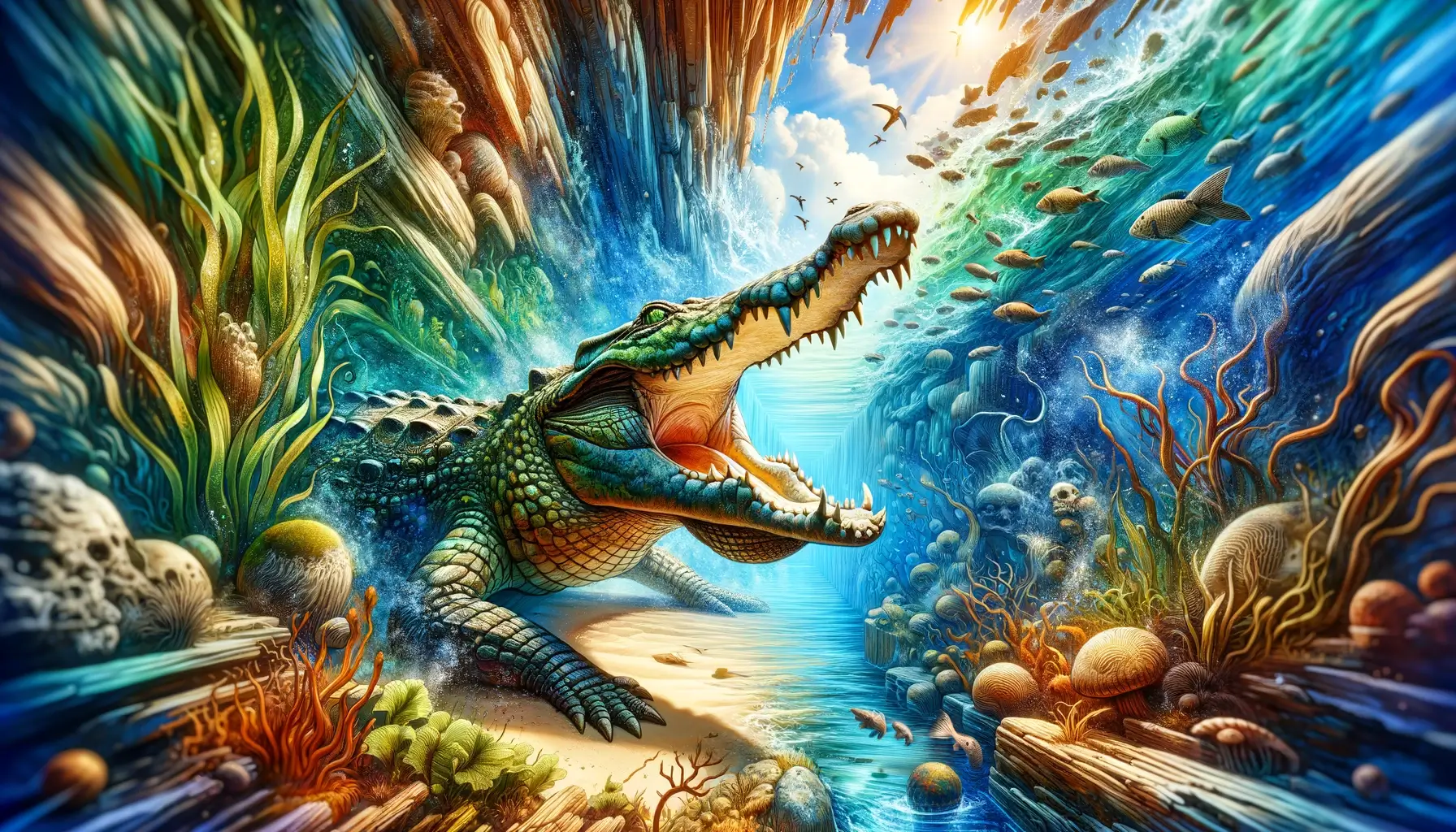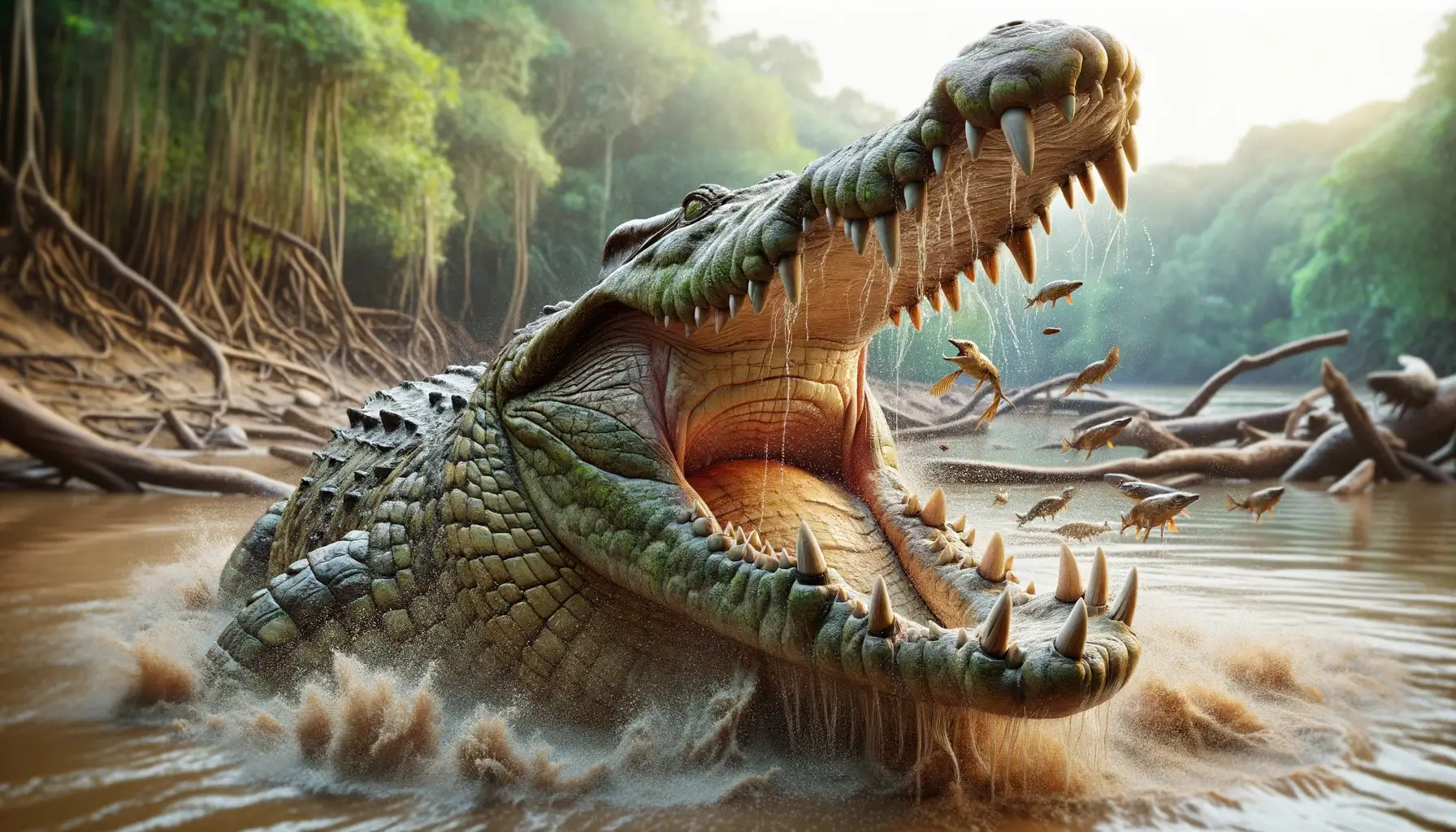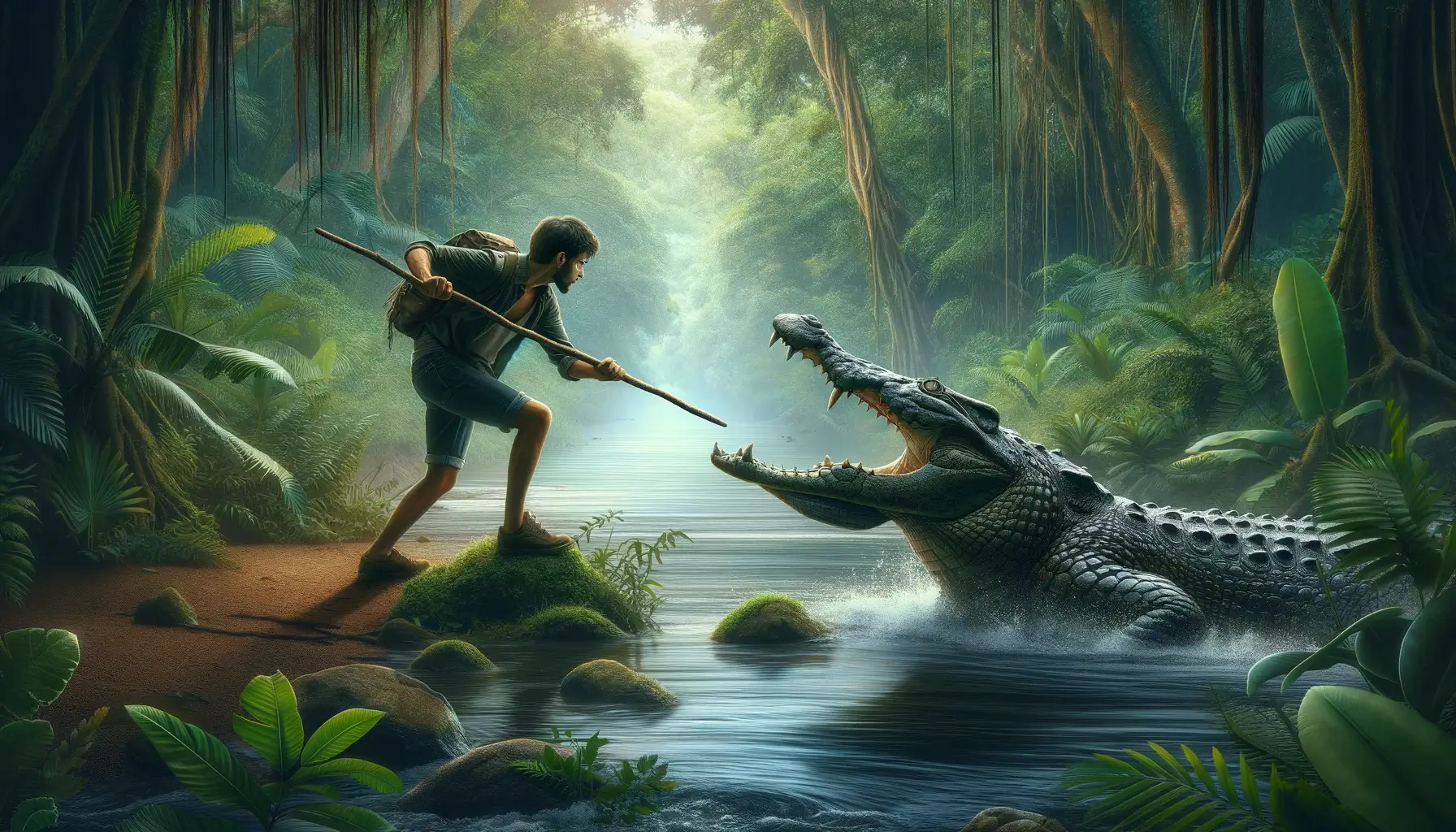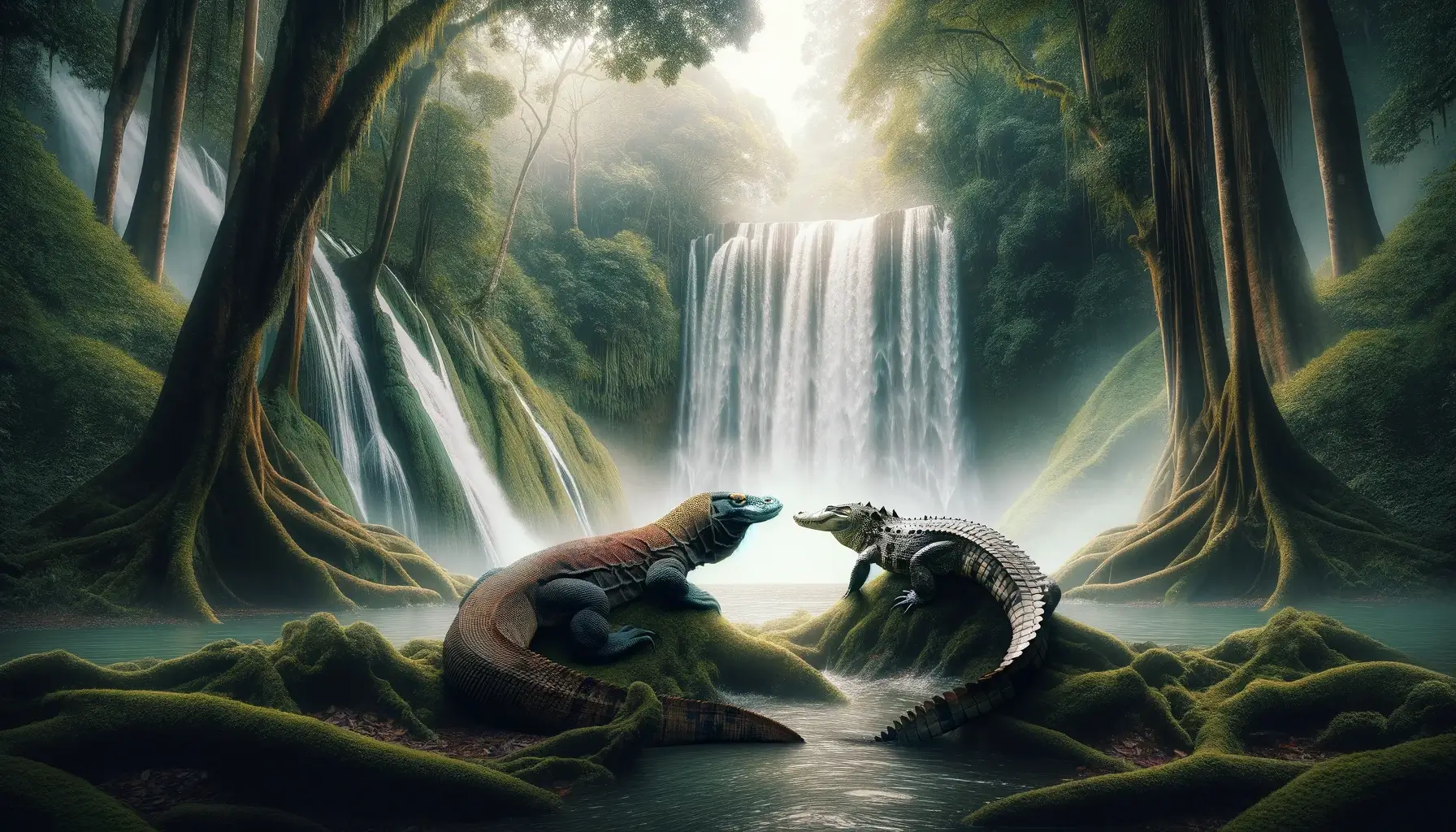Diving into the world of Komodo dragons, you’ll find these reptiles are not just the largest lizards on Earth but also possess an array of fascinating characteristics, making them one of nature’s most unique creatures. With a length of up to 10 feet and a weight of about 200 pounds, they easily dwarf their reptilian cousin, the crocodile monitor.
Their primary habitat is the Indonesian islands, where they’ve evolved to become apex predators. They’re known for their robust physique, impressive speed, and extraordinary hunting abilities. In the wild, it’s not uncommon to see a Komodo dragon vs crocodile showdown, where the dragon’s sharp teeth and venomous bite often give it the upper hand.
However, when we talk about a saltwater crocodile vs Komodo dragon, the dynamics might change. Saltwater crocodiles, being larger and more aggressive, could pose a significant challenge. Yet, the Komodo dragon’s intelligence and adaptability shouldn’t be underestimated.
You might be curious about a crocodile monitor vs a Komodo dragon face-off. While the monitor has size and weight advantages, the Komodo dragon’s venom and stealth could tip the scales. Each encounter is a testament to nature’s unpredictability and the freedom of these creatures to adapt and survive.
Komodo Dragon Vs. Crocodile
Imagine you’re stepping into an arena where two titans of nature are about to face off – the Komodo dragon, a lethal, land-based predator, and the crocodile, an aquatic behemoth with an infamous bite. You’re probably already aware of their formidable reputations individually, but have you ever considered what might happen if these two were to come head-to-head? Would the dragon’s venomous bite and swift agility outmatch the crocodile’s powerful jaws and stealthy water tactics? Or would the crocodile’s scaley armor and sheer size be too much for the dragon to handle? As we explore the unique characteristics and survival strategies of each, you’ll soon discover that this hypothetical match-up isn’t as straightforward as you might think.
Inside the Crocodile’s World
Stepping into the world of crocodiles, you’ll discover these formidable reptiles are not only among the largest predators on Earth but also display a range of intriguing behaviors and adaptations, making them a fascinating subject of scientific study. Crocodiles inhabit a wide range of habitats, from freshwater rivers to brackish marshes and saltwater beaches, demonstrating a remarkable adaptability to varying environmental conditions.

You’ll find that crocodiles have evolved a unique, energy-efficient hunting strategy. They’ll patiently wait, sometimes for hours, for the right moment to strike, exhibiting a level of discipline rarely seen in other predators. Their powerful jaws can exert tremendous pressure, allowing them to tackle larger prey and quickly end the struggle.
Crocodiles’ social structure is also intriguing. They’re often seen in groups, but these aren’t random congregations. They establish territories and observe a strict hierarchy, with larger and older individuals commanding respect from their younger counterparts. Crocodiles also demonstrate a surprising level of parental care, with females guarding their nests fiercely and assisting hatchlings to reach water after birth. By examining crocodiles, you’re delving into a world of evolutionary triumphs, complex behaviors, and astounding adaptations.
Size Comparison: Dragon Vs Crocodile
When you compare the sizes of a Komodo dragon and a crocodile, you’ll find a striking difference, with crocodiles generally being significantly larger and heavier. This isn’t just a minor discrepancy; we’re talking about a substantial size variation that affects not only the physical capabilities of these creatures but also their hunting strategies and survival techniques.
-
Komodo Dragons
- Adult Komodo dragons typically reach lengths of 7-9 feet and weigh around 150-200 pounds. Their size allows them to be swift and agile on land.
-
Crocodiles
- On the other hand, an adult crocodile can easily reach lengths of 13-20 feet and, in some cases, even larger. Their weight can surge up to an astonishing 2000 pounds, making them one of the heaviest reptiles on Earth.
It’s clear that in terms of size, the crocodile holds a significant advantage. This size difference, however, also translates into the distinct lifestyles, hunting methods, and survival strategies that each of these formidable creatures employs. So when you’re out exploring, remember that size does matter, especially when you’re dealing with wildlife as impressive as Komodo dragons and crocodiles.
Dragon’s Deadly Bite
Despite their size disadvantage, Komodo dragons pack a deadly punch with their venomous bite. They possess a unique combination of venom and a suite of bacteria in their saliva that can bring down even large prey. When you’re face-to-face with a dragon, it’s not just the venom you should worry about. Their bite is a cocktail of death, a lethal mix of venomous proteins and pathogenic bacteria.
The venom rapidly lowers blood pressure, expedites blood loss, and sends a victim into shock. Simultaneously, the bacteria cause sepsis, leading to further bodily distress. To make matters worse, the dragon’s serrated teeth, similar to those of a shark, cause significant tissue damage. This not only allows for easier venom and bacterial entry but also facilitates substantial blood loss.
Researchers have identified over 50 bacterial strains in a dragon’s mouth, some of which are highly septic. This deadly concoction is what makes the Komodo dragon a formidable predator. So, while the crocodile may have size on its side, the dragon’s bite levels the playing field. This fascinating biological weapon, wrapped in the form of a dragon’s bite, shows that size isn’t everything in the wild.
Crocodile’s Crushing Jaw Strength
In the wild, a crocodile’s jaw strength is a formidable weapon, capable of delivering a crushing force of up to 3,700 pounds per square inch. This power, equivalent to the weight of a small car, far surpasses any human’s bite force, which averages around 162 pounds per square inch.

This jaw power allows crocodiles to:
- Tear apart flesh and bone with ease
- This provides them the freedom to consume almost any animal they can grasp in their jaws.
- Crack open hard turtle shells
- This ability gives them access to nutrient-rich meals that other predators can’t manage.
- Defend themselves from threats
- This strength ensures they remain one of the most feared creatures in their habitat.
Their jaw muscles, which consist of slow-twitch fibers, allow them to maintain this force for extended periods without tiring. Their bite, combined with their powerful tail and armored skin, makes them an apex predator in their environment. In a face-off with a Komodo dragon, the crocodile’s superior jaw strength could give it a significant advantage.
Survival Strategies: Komodo Dragon
While the crocodile’s jaw strength is impressive, the Komodo dragon’s survival strategies are equally fascinating and effective in their own right. You might think of the Komodo dragon as just a giant lizard, but it’s more than that. It’s a survivor, honed by millions of years of evolution.
The Komodo dragon’s primary survival strategy revolves around its venomous bite. Contrary to popular belief, it’s not bacteria but venom that brings down the dragon’s prey. This venom induces shock and prevents blood clotting, leading to a swift demise for any creature unfortunate enough to be bitten.
Aside from this, the Komodo dragon relies on camouflage and patience. It can stay motionless for hours, blending into its surroundings until prey comes within striking distance. Once there, it can rely on its powerful legs to sprint at surprising speeds.
But don’t mistake this as an easy life. These dragons must also contend with intraspecies competition, often engaging in fierce battles for territory or mates. They’re solitary creatures, relying on their own strength and cunning to survive. So, don’t underestimate the Komodo dragon. It’s a testament to the power of adaptation and the will to survive.
Survival Tactics: Crocodile
Shifting the focus to the crocodile, its survival tactics are as formidable and refined as the Komodo dragon’s, with a unique set of strategies honed by nature’s harsh trials.
The crocodile’s tactics can be classified into three main categories, each with distinct sub-strategies:

-
Camouflage and Ambush
- Blends into the surroundings with its green-brown scales.
- Lurks underwater, exposing only its eyes and nostrils, ready to strike unsuspecting prey.
-
Powerful Jaws and Body Armor
- Possesses the most powerful bite of any animal.
- Uses its thick, armored skin as a shield against predators and for thermoregulation.
-
Survival and Reproduction
- Can survive without food for long periods, reducing metabolic rates.
- Lays eggs in nests and guards them fiercely, ensuring the survival of the next generation.
Your respect for crocodiles might increase when you consider their survival prowess. Their ability to adapt to their environment, their physical strength, and their reproductive strategies are all testaments to their resilience in the face of nature’s challenges. It’s a stark reminder that even in an age yearning for freedom, survival in the wild still depends on a creature’s innate ability to adapt, endure, and reproduce.
Speed and Agility: Who’s Quicker?
Now, let’s delve into the intriguing topic of speed and agility and determine which of these formidable creatures – the Komodo dragon or the crocodile – holds the edge in quickness.
On land, you’d be surprised to find that the Komodo dragon takes the lead. These massive lizards can reach speeds up to 12 miles per hour, making them remarkably agile predators in their native habitats. Their long, muscular legs allow them to sprint after prey, using their speed as a primary hunting advantage.
In contrast, the crocodile, while not as speedy on land, is a master swimmer. In water, it can reach speeds of up to 20 miles per hour, which is where it takes the crown. The crocodile’s streamlined body, coupled with powerful tail propulsion, enables this swift aquatic acceleration.
Evidently, the Komodo’s speed advantage is land-bound, while the crocodile dominates in aquatic environments. Therefore, the winner in speed and agility greatly depends on the terrain. For those who crave freedom, understanding the strengths and weaknesses of these animals could serve as a metaphor for the importance of adaptability in different environments.
Battle Scenarios: Land Vs. Water
In exploring potential battle scenarios between the Komodo dragon and the crocodile, we must consider the critical role played by the location of the encounter – land or water?
On land, it’s the Komodo dragon’s home turf. They’re agile and quick, and their venomous bite is lethal.
However, the crocodile is not without its advantages:
- Its thick, armored skin gives it strong protection against the dragon’s bite.
- However, the dragon’s venom could still be a game-changer if it gets through.
- It has a powerful tail that can be used as a weapon.
- But the dragon is nimble and might dodge it.
- It has a death roll, a technique used to disorient and drown its prey.
- But this would be less effective on land.
In water, the tables are turned. The crocodile is an efficient swimmer, and its death roll becomes much more deadly. The Komodo dragon, while capable of swimming, is at a significant disadvantage:
- It’s slower and less agile in the water.
- Its venomous bite is less effective.
- It’s at risk of drowning in the crocodile’s death roll.
Conservation Status: Threats and Protection
While the battle between a Komodo dragon and a crocodile may spark intrigue, it’s the fight against extinction and habitat loss that truly poses a threat to these remarkable creatures. Both species face considerable challenges to their survival.
Komodo dragons, listed as vulnerable by the IUCN Red List, are mainly threatened by habitat loss due to human activities, including illegal poaching and wildfires. Their population, confined to a few Indonesian islands, is estimated to be around 6,000, a number which continues to dwindle.
On the other hand, crocodiles, despite their vast geographical range, are not exempt from danger. Several species, such as the critically endangered Orinoco crocodile and the Philippine crocodile, face threats from hunting, pollution, and habitat degradation due to human encroachment.
Conservation efforts are crucial for the survival of these majestic creatures. You can contribute to their preservation by supporting organizations dedicated to their protection, advocating for strong wildlife laws, and promoting sustainable tourism practices.
Human Interaction: Risks and Encounters
Despite their often secluded habitats, both Komodo dragons and crocodiles have had significant encounters with humans, posing risks that need careful management and understanding. If you’re someone who’s intrigued by these creatures and longs for the freedom to explore their habitats, there are a few key points to keep in mind.
-
Interaction Risks:
- Komodo dragons, with their venomous bites, may pose a threat if you stumble upon their territories. They’re not usually aggressive towards humans, but unexpected encounters could lead to danger.
- Crocodiles, on the other hand, are more often in conflict with humans due to their broader distribution and predatory nature. Their powerful jaws can cause fatal injuries.
-
Encounters:
- Komodo dragon encounters are typically limited to the Indonesian islands, where they naturally inhabit.
- Crocodile encounters are more widespread, occurring in various tropical regions worldwide.
-
Management:
- For both species, it’s critical to respect their habitats, maintain safe distances, and avoid provoking them.

